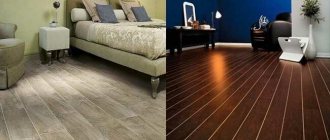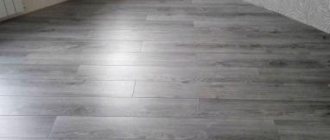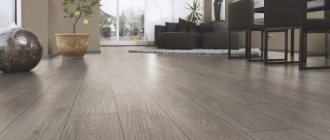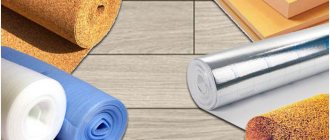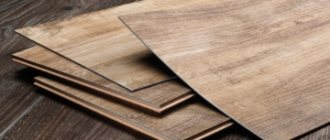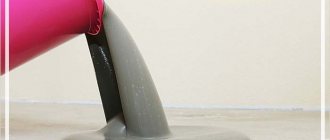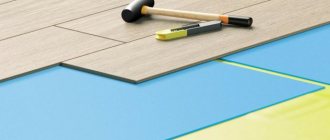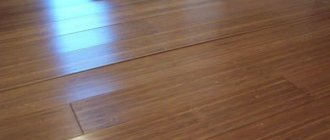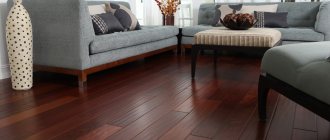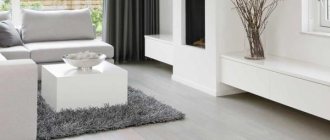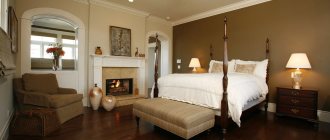When deciding on the flooring for an apartment, many have difficulty choosing between parquet and laminate. Parquet used to be in almost every standard apartment, and as soon as laminate boards appeared - a beautiful, fashionable and attractive coating - many appreciated its aesthetic appearance, ease of installation and resistance to external influences.
Over time, many have come to appreciate the good old parquet flooring more - for the fact that it is still a natural material that can be repaired and restored, as a result of which it acquires a quite presentable appearance, while being environmentally friendly and safe for health. New types of parquet have also appeared, and laminate has become even more reliable. How can you not get confused when choosing. Let's look at all the advantages and disadvantages of these two popular materials.
The principle of laminate construction
The very name of this type of coating comes from the structural features. The term translates as “multilayer coating”. It is the structure that provides the features of this type of coating, which include both pros and cons.
The main difference between laminate and parquet boards is its design. The stabilizing layer of the laminate is chipboard (fibreboard). It is responsible for the fireproof properties of the laminate. Under the chipboard there is a layer of plastic or paper impregnated with resinous substances, which guarantees the material protection from moisture. Treating all edges with a wax-containing impregnation also protects the boards from moisture.
The top layer is decorative, made of paper. It is he who is responsible for the attractiveness of the coating. It can be very different - wood, with a tile pattern, stone, with any fashionable texture.
A high-quality print allows you to accurately convey the texture, which makes the coating very similar to natural. The top layer is coated with melamine resin, which gives it strength, reliably retains color and protects it from external influences. It does not fade, does not lose brightness, does not scratch, does not get wet.
Advantages and disadvantages of laminate
There is an opinion that laminate is fragile, quickly breaks down and loses its appearance. However, this is not so - the strength of the laminate depends on its class, and the class, in turn, is selected depending on the planned use. It is hardly worth paying extra money to get a floor in the nursery that is stronger than street tiles, where many people pass during the day. In the same way, you should not skimp on the wear resistance of the flooring in the kitchen or living room, where there are always a lot of people or which is actively and frequently used.
If someone decided to save money and chose a weak type of laminate, but it quickly wore out due to excessive load, this is a mistake in selecting the right class of material. Laminate is divided into strength classes: durable and moderate strength. Durable - these are classes 31, 32, 33, the so-called commercial ones. They are used for offices, industrial premises, public places or for the most actively visited areas of the house. It looks reliable, lasts a long time and is not easily damaged.
For an office, bedroom or nursery, you can choose classes with less strength, 21, 22 and 23.
Strengths of laminate:
- It is easy to care for, it always looks good and does not attract dust.
- It is abrasion resistant, not easy to scratch, and can withstand impacts. The higher the class, the higher the resistance of the laminate to mechanical stress.
- It is resistant to compression.
- It is resistant to fading, retains color for a long time, and does not come into contact with chemicals during cleaning.
- It is suitable for organizing heated floors.
- It’s not difficult to choose the right shade, pattern, texture – the choice is huge.
- It installs quickly and easily. Installation can be done even by non-professionals.
Weaknesses of laminate:
- Does not tolerate high humidity well: it can quickly lose its properties.
- Not for outdoor use.
- Requires additional sound insulation during installation.
- Cannot be repaired, only replaced.
- From the outside it is clear that the material is artificial.
As you can see, the material is durable, reliable, lasts a long time (by the way, it has a 5-year guarantee), it is easy to handle, there is no fear that it can be damaged, rather, on the contrary - it is quite difficult. The only thing that needs to be taken into account is that it is advisable to lay down sound insulation during installation and it is better to choose a distinctly artificial pattern so that the effect of an unsuccessful fake is not obtained. You should also avoid using such a coating in rooms with high humidity, otherwise the structure will dry out and lose its strength and stability, but in such rooms it is already common to use tiles.
Here are the most common opinions that are fundamentally wrong
Repair
Laminate flooring cannot be repaired; parquet flooring cannot be repaired. In fact, there are very few craftsmen who are able to carry out high-quality repairs. The cost of such work is extremely high, so they often resort to replacing the damaged area. And here the situation arises that there is practically no difference in such repairs between laminate or parquet floors. Even if the repair is carried out at a high level, the appearance of the repaired board will be visually different from the entire canvas. And if the “floating floor” method was used during installation, then it is impossible to carry out repairs. Treated boards will begin to sag; this has been proven in practice.
Why choose parquet boards?
It is generally accepted that parquet is a natural covering and this is its main difference from laminate. However, the main difference is different, and such a statement is not entirely true.
The peculiarity of parquet boards is its structure. The part that we see usually consists of valuable wood. This is a thin layer ranging from just over two to six millimeters thick. It is covered with a protective layer - a special varnish that protects the wood from various influences.
Under the layer of wood there are narrow dies - lamellas - which make up the main, central layer of the parquet board. They are located perpendicular to the board and have a fastening for connection with the adjacent board. The bottom layer is natural plywood about 2 mm thick.
When asked why parquet is chosen, I would like to remind you, first of all, that laminate was created as a more budget-friendly substitute for parquet. Parquet boards are chosen for the beauty of their natural pattern, durability, and almost endless service life. Not for environmental friendliness, as some people think. Laminate can also be made from natural ingredients. But laminate cannot be restored, while parquet boards can be sanded, which allows you to completely renew its outer layer.
For more information about the difference between parquet and laminate, watch the video:
The main thing why people love parquet is its good appearance - an indicator of prosperity, self-respect, and naturalness.
Pros and cons of parquet
Like any covering, parquet has its advantages and disadvantages.
Let's start with the pros:
- Made from natural wood, the coating reliably protects against external noise.
- Parquet boards do not attract dust.
- The coating is harmless. The coating with a special varnish without toxic formaldehyde, produced under industrial conditions, is very durable and at the same time safe.
- The possibility of endless restoration makes the coating eternal.
- The natural look of parquet flooring cannot be replaced by anything.
- Caring for parquet boards is quite simple.
- A variety of ways to lay modern parquet.
- Long service life. Manufacturers provide a guarantee of up to 10 years.
As you can see, the main advantages of parquet boards are strength, indestructibility and aesthetics. However, it is important to pay attention to the fact that restoring a parquet board is labor-intensive; the thicker the board, the more times it can be restored; restoration can cost as much as buying laminate, which is more wear-resistant, so the desire to have a natural coating with a natural wood pattern usually wins , a longer natural service life and the realization that the floor in the apartment is covered with a layer of real wood, which has its own unique energy.
And the variety of sizes, installation methods, coating colors, and parquet allows you to get an ultra-modern solution from old parquet, and find very original solutions among new products.
Natural wood is not always the strongest material. For the outer layer of parquet, they usually use such durable and noble species as oak - the leader in strength, beech - light and delicate, therefore a favorite material for children's rooms, cherry - rich in shades, walnut - wear-resistant and unpretentious, maple - less elite, but quite durable . For the bottom layer, pine or spruce is usually used - natural, warm, but vulnerable to abrasion. If you use pine as the outer layer, the floor will be beautiful, natural, but will wear out faster. There are a number of features regarding larch - such features of wood as a tendency to cracks and porosity can turn out to be both a plus and a minus.
Disadvantages of parquet boards:
- Parquet boards do not like moisture, so they are not suitable for rooms with high humidity.
- Parquet varnish wears off over time and requires restoration.
- The service life and type of parquet are influenced by the indoor climate.
- Parquet boards on warm floors require a number of precautions.
Unlike laminate, parquet boards are recommended for heated floors with a number of precautions, but a lot depends on the quality of the parquet. Typically, when making parquet, harmful compounds are not used, especially those that exhibit negative properties when heated. For the decorative layer, use well-dried high-quality wood, otherwise cracks will appear. If these conditions are met and fire safety measures are met, you can install parquet flooring on the heated floor system. However, during operation it is important to comply with several requirements: keep the temperature uniform, avoid too high heating, temperature changes, frequent heating on and off, do not lay carpets on a floor with parquet on a warm floor. Then the parquet flooring will last a long time and look great.
Thermal conductivity of materials
Thermal conductivity of materials (photo No. 6)
Laminate conducts heat better than parquet boards. In other words, it heats up and cools down faster. In a house with a conventional heating system, when choosing laminate, parquet or linoleum - which is better, it makes sense to choose parquet and parquet boards. It is comfortable to walk on them barefoot even in winter.
However, these products cannot be used for heating underfloor heating. Whereas laminate is possible. In this case, high thermal conductivity becomes its advantage. The flooring warms up faster and transfers heat better to the air in the room.
Criterias of choice
It is believed that the main disadvantage of parquet is its higher price, but this is not entirely true. There are both materials of higher and lower quality and wear resistance, and prices differ depending on the characteristics. With equal characteristics, a parquet floor will cost more, and so will its maintenance.
If the priority is indestructibility, it is better to give preference to laminate, if natural beauty - to parquet.
If your interior is dominated by natural wood furniture, it is better to give preference to parquet; if metal predominates, you can take a closer look at a spectacular laminate.
If it is easier for you to re-lay the floor than to restore it, it is also better to give preference to laminate. The same goes for cleaning - with laminate it will be easier thanks to a more reliable protective layer.
Cost of flooring materials
Cost of flooring materials (photo No. 11)
The cost of both products varies greatly. You can buy a budget parquet board or an expensive high-quality laminate. When deciding what is better - cheap parquet or expensive laminate - you should definitely give preference to the second.
A durable, certified laminate from a reputable manufacturer will cost more than the average parquet board.
Tip: Decide how important water resistance of the floor is to you. Water-repellent materials are more expensive, but are indispensable in the kitchen, bathroom or hallway.

